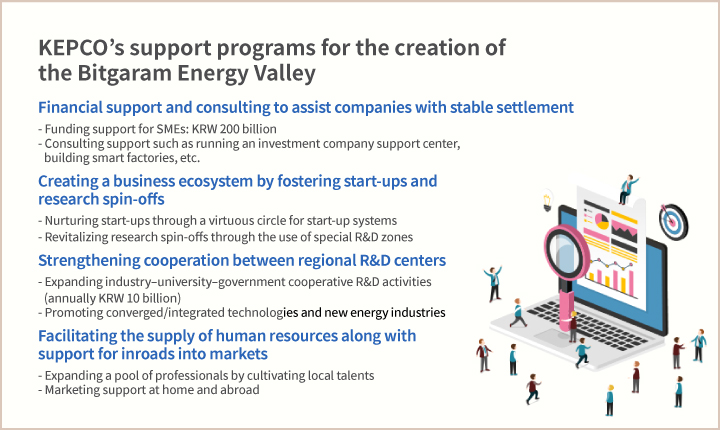Promising Businesses
Promising Business Fields Proposed for New Plans
1. Diversification of the Petrochemical Industry

Our focus is on the expansion of new growth engines by advancing petrochemical complexes and fostering the materials industry based on the Yeosu National Industrial Complex, the mecca of the basic materials sector, and the petrochemical production infrastructure of the Gwangyang Bay Area.
- Areas: Yeosu National Industrial Complex, Gwangyang Bay Area Free Economic Zone, etc.
- Target business : Chemicals with special functions needed to produce electrical and electronic equipment, automobiles, secondary batteries, rubber, plastics, and pharmaceuticals
- Development plan
Development plan Advanced Petrochemical Complexes Promote the Materials Industry Bolster R&D Capacities - Develop the Yeosu Innovation Industrial Complex
- Establish platforms for commercializing high value-added CO2 business
- Build an integrated safety control system in the Yeosu National Industrial Complex
- Create a functional chemical materials cluster
- Establish foundations for commercializing high-performance, high-tech rubber
- Cultivate high-tech advanced materials/parts industries
- Strengthen industry–university cooperation networks
- Support SME-tailored packages
- Comparison of other chemical complexes in Korea : (Yeosu National Industrial Complex) Since the creation of the Yeosu petrochemical industrial complex in 1979, it has played a pivotal role in the regional economy while being recognized as Korea’s largest petrochemicals producer.
- Oil refining : 28% of the nation’s total oil refining capacity (GS-Caltex: 840,000 barrels/day)
- Petrochemical : 46% of the nation’s total ethylene production capacity (ethylene: 4.14 million tons/year)
- Fertilizer : 32% of the nation’s total production capacity (Namhae Chemical: 1.36 million tons/year)
- -* Ethylene production capacity (KT/year) : Yeosu (4,140), Daesan (3,240), Ulsan (1,660)
2. Metal Materials Processing Industries

Based on Gwangyang Steelworks, efforts are put into developing the metal materials processing industries, which can build platforms for the iron and steel industries and lead precision machining technology, into a high value-added industry.
- Areas: Suncheon (Yulchon First Industrial Complex and Haeryong Industrial Complex), Boseong, Mokpo, etc., in the eastern and western regions of Jeollanam-do
- Target business: Magnesium alloys, carbon fiber, ceramics, auto and bike parts, polymer-based fusion/composite materials, etc.
- Advantages
Easy access to the Chinese market due to its proximity to China’s largest market, Shanghai
Easy supply of parts to the Kia Motors plant and the Samsung Electronics plant in Gwangju
- Development plan
Development plan Create platforms for the iron & steel industries and clusters Lead precision machining technology Provide customized support for companies and R&D - Materials for higher metal resource capacity
- Materials for energy and transporters
- Next-generation, green, and high-performance materials
- Materials for higher life quality and safety
- High-performance materials applicable to other industries
- Technology partnerships with internal/external institutions
- More advanced metalworking technology
- Stronger inter-industry collaboration
- Creation of high added value
- Higher competitiveness through technology packages
- Development of new technology via cooperation between large companies and SMEs
- More advanced technical personnel
3. Diversification of the Shipbuilding/Marine Industries

On the basis of the natural coastline, Jeollanam-do has been promoting the construction of small- and medium-sized vessels and smart and eco-friendly vessels. It has also been creating the ecosystem of higher value-added shipbuilding and marine industries in response to the era of the Fourth Industrial Revolution.
- Areas: Southwestern coastal regions including the Daebul National Industrial Complex
- Target business : Construction of leisure vessels, smart/eco-friendly shipbuilding and ship equipment, and ship repair services
- Advantages
Establishment of foundations for promoting the high value-added shipbuilding/marine industries
A. Foundations for technologies to modernize and upgrade leisure vessel parts/equipment and for offshore tests on small vessels
B. Construction of a marine cable testing and research center and a ship repair service support system
C. Foundation for the marine leisure equipment industry in the southwestern coastal regionSupport for the commercial diversification of the shipbuilding/marine industries including technological development for the discovery of new food products
Proximity to superb domestic medium and large shipbuilders including Hyundai Samho Heavy Industries and Daehan Shipbuilding
4. Bitgaram Energy Valley

Come and seize business opportunities in Korea’s largest energy and ICT convergence industrial city, Bitgaram Innovation City, equipped with different supporting systems for tenant companies including R&D. It is now composed of 16 public organizations including Korea Electric Power Corporation (KEPCO), Korea’s largest energy company, KEPCO KDN, and KEPCO KPS.
Gwangju-Jeonnam Joint Innovation City
- Areas : Geumcheon-myeon and Sanpo-myeon in Naju-si, Jeonnam (7,361,000㎢)
- Planned population : A self-sufficient, independent new city with 50,000 residents / 20,000 households
- Relocated organization : 16 public organizations including KEPCO
Bitgaram Energy Valley
- Investment target
Partners of relocated public organizations, research laboratories, and private knowledge industry centers
Sites for industry–university–government clusters (energy/ICT, venture, and software companies)
Private knowledge industry centers that can meet the features of ICT/content SMEs
- Advantage
Centered on Bitgaram Innovation City, a new energy project belt will be created, which encompasses the southwestern and eastern regions of Jeollanam-do, finally to become the capital of the global energy industry.
Discovery of new energy projects through industry–university–government cooperation networks including KEPCO
Provision of diverse support programs for the Energy Valley Enterprise Development Institute, relocated companies / Business Incubation Center, R&D centers.
Establishment of branch institutes such as Energy & New Technology Laboratory, KEPCO KPS Human Resources Development Center, and Korea Electrical Manufacturers Association

5. Eco-Friendly Future Automobile and Car Tuning Industries
Every effort has been put into creating a micro-mobility ecosystem involving electric vehicles and into clustering car tuning industries including automotive restoration service and high-performance auto parts marketing service.
- Area : Daema General Industrial Complex in Yeonggwang-gun and the Sampo District in Samho-eup, Yeongam-gun
- Target business : Production of eco-friendly electric vehicles/bikes, and tuning parts and production of advanced auto parts, etc.
- Advantage
Creation of an eco-friendly future automotive cluster
Korea’s unique one-stop service for developing and testing/evaluating high-performance auto parts linked with the Korea International Circuit (Grade 1)
Operation of an R&D center dedicated to key technologies for high-performance automobiles (equipped with 27 types of instruments for testing/evaluating parts), along with the creation of an automobile tuning Valley
Establishment of foundations such as the e-mobility cluster, the e-mobility support center, etc.
※ Provision of low-priced sites, discounts on/exemption of and priority over the use of F1 circuit and different test / evaluation instruments, support for employment subsidies, tax reduction/exemption as an enterprise city (corporation/income taxes: 100% for the first three years and 50% for the next two years), and engineering services for technological development based on the use of research institutes
6. Aerospace Industry
A rocket R&D center, a national flight performance test center, and a specialized drone knowledge industry center are being established in cooperation with the Naro Space Center in Goheung. In addition, the aviation industry is being fostered as a driving force for future growth by integrating flight training centers around Muan International Airport and Yeongam Airfield.
- Area : Naro Space Center in Goheung, Muan International Airport, and Yeongam Airfield
- Target business : Aircraft flight test/certification, aircraft maintenance, flight training centers, airlines, the development of KSRs (Korea Sounding Rockets), etc.
- Advantage
Support for the development of advanced technology in cooperation with Naro Space Center
Establishment and operation of different ground testing facilities needed to develop rockets
24-hour services available at the large international airport, Muan International Airport
Convenient access due to proximity to China, Japan, and other regions in Korea
Muan International Airport has top-notch investment conditions in Korea
- Closest point of access to China and Japan
It is within a 90-minute travel time to multiple international airports such as Shanghai, Hong Kong, Tokyo, etc.)
- Korea’s optimized private airport available 24 hours a day
Days of fog and snow: 13 and 3.2, respectively (Incheon International Airport: 60 days of fog)—recognized as fewest in Korea
- Large international airport operating facilities compared with Korean airports
Development Plans Name Size Capacity Remarks Site 2,567,690㎡ Runway 2,800m×45m 140,000 flights/year 400 meters being extended Apron 90,962㎡ 9 aircraft stands 4 B747s, 3 A300s, 2 B737s Passenger Terminal 29,106㎡ 5.19 million/year 4.16 million (home), 1.03 million (abroad) Cargo Terminal 3,112㎡ 50,000 tons/year 41,000 tons (home), 9,000 tons (abroad) Parking Lot 66,900㎡ 2,095 vehicles Parking at a time
7. Food and Bio-Industries
The abundant natural resources of Jeollanam-do are utilized to develop bio-industries such as functional food, vaccines/pharmaceuticals, natural products, and medicine/cosmetics as future strategic industries. Moreover, different programs are available for food and pharmaceutical start-ups.
- Area: Naju, Hwasun, Jangseong, Gokseong, etc., in the vicinity of Gwangju, and the south-central region of Jeollanam-do (Jangheung)
- Target business: Functional food, biopharmaceuticals (vaccines), nanobiotechnology, and natural medicine/cosmetics, etc.
- Advantage
Utilization of a database of 250 kinds of comparatively advantageous natural resources such as hwangchil (yellow dye), turmeric, Stauntonia hexaphylla, and more
Availability of facilities and equipment of six R&D support centers including Jeonnam Bioindustry Foundation and support for their professional researchers
Focus on supporting vaccine/pharmaceutical start-ups in cooperation with the Hwasun Vaccine Industry Special District and Chonnam National University Hwasun Hospital
8. New and Renewable Energy
We are leading the new and renewable energy industries involving photovoltaics, wind and tidal power, and bioenergy on the basis of comparatively advantageous resources such as Korea’s largest amount of sunshine, abundant wind, and rapid ocean currents.
- Area: Southwest coastal areas
- Target business: Wind farms, photovoltaic/tidal power stations, hydrogen fuel cells, biofuels, etc.
- Advantage
The best location for solar photovoltaic power generation due to its largest quantity of solar radiation in Korea
(Daily average quantity of solar radiation: 3.89 kWh/㎡, 7% higher than the nationwide average of 3.63 kWh/㎡)
Infinite potential for the growth of offshore wind power generation (at least 60% of the nation’s potential offshore wind power)
(Wind power: 19 GW, approx. 19.3% of the nation’s 96.7 GW)
The best place for tidal power due to the rapid ocean currents of its archipelago
(Ocean energy (currents): approx. 9.6 GW, about 80% of the nation’s 12 GW)
9. High Tech Ceramic Industry
The high-tech ceramics industry is being promoted as the future high value-added, new growth engine of the southwestern region of Jeollanam-do.
- Area: Mokpo Daeyang General Industrial Complex, Mokpo Ceramic General Industrial Complex, and Gwangyang Bay Area
- Target business: Ceramics, functional ceramics, raw materials, and parts industries, etc.
- Advantage
Support programs are provided to develop new products through the joint utilization of the pilot production equipment of Korea’s unique total ceramic support center at Mokpo National University.
10. Logistics Industry
The logistics industry has been growing on the basis of Muan International Airport and Jangseong Integrated Freight Terminal, both of which serve as the hub of the southwestern region of the Korean Peninsula, as well as the Port of Gwangyang and Mokpo New Port, both of which act as the mecca of exchanges in Northeast Asia and Pacific nations while connecting China and Southeast Asia.
- Area: Southwest coastal areas, the hinterland of Gwangyang Port and Mokpo New Port, Jangseong Integrated Freight Terminal, and Muan International Airport
- Target business: Ports of call for forwarders and airlines, logistics transferring, processing, and distribution, etc.
- Advantage
Gwangyang Port and Mokpo New Port are located on the important international waterways allowing more efficient import and export processes.
Provision of incentives such as exemption of or reduction in rental fees for hinterland and port loading and unloading costs.
Honam Integrated Freight Terminal (Jangseong) plays as a bridge connecting inland areas across the country.
11. Cultivation of Regional Strategic Industries in Response to the Fourth Industrial Revolution
Regional strategic industries are being pursued in conjunction with the introduction of “Regulation-Free Zone” is a system that resolutely deregulates existing regulations. Jeollanam-do has selected new industries in the energy sector (power SI and chemical materials) and the drone industry as its strategic industries.
New industries in the energy sector (power SI and chemical materials): Creating an advanced base for exporting smart grids
- Development plan
Energy prosumer demonstration projects to revitalize regionally decentralized energy exchanges.
Establishment of a pilot electricity brokerage market where power from dispersed generation, such as new and renewable energy, can be transacted
* Energy prosumer: A power exchange market where electricity is purchased/sold between a producer and consumerEstablishment of foundations for developing intelligent, eco-friendly electrical power equipment and evaluating the performance
Construction of testing infrastructure to implement 31 technology development tasks involving smart digital substation systems and ensure their quality
- Special cases concerning the regulations
Introduction of more efficient approval and/or permission processes and regulatory innovation systems such as a regulatory sandbox
Creation of Gwangju–Jeonnam Joint Innovation City (15 km2) as a national innovation cluster centered on the exploration of new industries in the energy sector
Deregulation of national parks in the islands (replaced by reporting to the park management director within a range of 5%)
Stable power supply and energy self-sufficiency through the creation of 50 energy-independent islands including Heuksando Island
Relaxation of the collection of expenses incurred in using infrastructure as usage fees (10% → 3% of total benefits)
Relaxation of collection of expenses as usage fees from total benefits in case of offshore solar plants and panels installed in idle sites are used for any other purpose
Unmanned (drone) industry
The unmanned (drone) industry is being fostered as a future industry that is connected with the existing aviation testing/evaluation infrastructure, outstanding airspace, the Fourth Industrial Revolution, and government projects.
- Area: Throughout Jeollanam-do
- Target business : Creation of a drone ecosystem involving infrastructure for testing/evaluation, certification, validation, HR training, etc., and the attraction of businesses
- Advantage
Korea’s best conditions for flight tests (airspace, etc.) including piloting an unmanned aircraft
Location of the National Comprehensive Flight Performance Test Center, Korea’s unique facility dedicated to testing flights for private use



